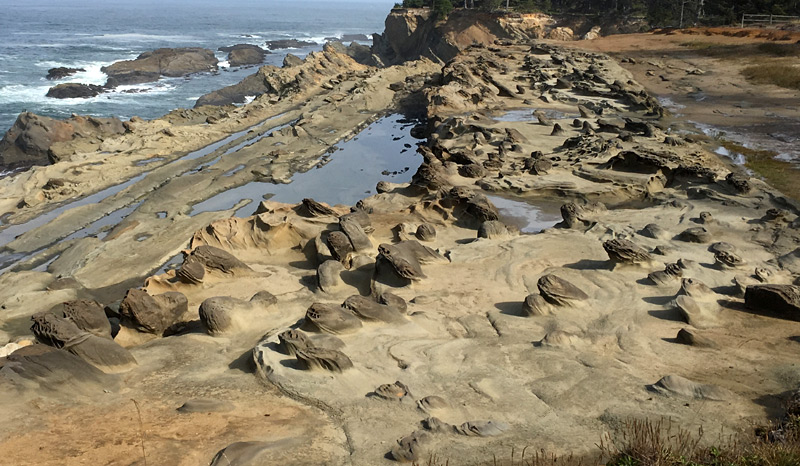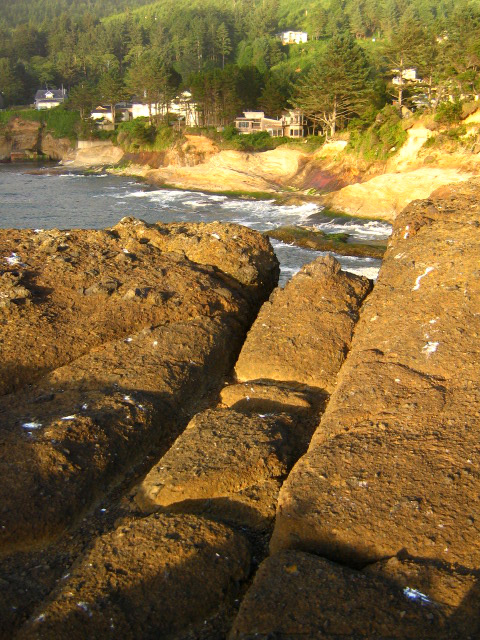Bizarre Rocky Details of Oregon Coast: What's Really Going On
Published 03/22/21 at 5:50 AM PDT
By Oregon Coast Beach Connection staff

(Oregon Coast) – Sure, everyone loves the sandy beaches of the Oregon coast, but it’s the rocky areas that are by far and away the most interesting. Hypnotizing shapes and features abound, and there’s so much more going on there than you’d imagine. (Photo above courtesy Coos Bay / North Bend Visitors / Janice Langlilais)
Three areas provide some of the wildest structures: Yachats, Coos Bay and Depoe Bay.
Down at Coos Bay, Shore Acres State Park often looks like an alien world, more so than any other spot on the coast, with the top of Cape Kiwanda in second place. There’s an intensely wide array of configurations and shapes there – like they came from Dr. Suess, the Yes album covers done by Roger Dean, or even just the mind of Frank Zappa.
Even crazier, they all have a different explanation, all provided by Oregon coast geologist George Mustoe.

Courtesy Coos Bay / North Bend Visitors / Janice Langlilais
First there are concretions, those grayish or even whitish blobs that sometimes look like cannon balls. Mustoe said they started with sand deposits maybe millions of years ago, and then water seeped into them, leaving behind minerals. Over time these hardened and kept growing as more material enveloped them.
The jagged and irregular shapes you see all over are often the result of salt weathering. This is where all that wave action not only pounds away the rocks but it leaves behind salt crystals when the water evaporates. Rocks here are quite porous so the salt crystals over time grow and split the rocks apart over and over. That often takes millions of years.

Courtesy Coos Bay / North Bend Visitors / Janice Langlilais
Those salt crystals also help create all those honeycombed shapes here, but ocean algae blocks some of the inner erosion and creates smooth shapes.

Pits at Shore Acres, photo courtesy Brent Lerwill (no, the child is not a geologic formation)
Other spots have pits, which come from something else (see the Yachats section). These can get widened by wave action too. More on Coos Bay Complete Guide - South Coast Hotels

Includes exclusive listings; some specials in winter
In Cannon Beach:
Includes rentals not listed anywhere else
In Manzanita, Wheeler, Rockaway Beach:
Some specials for winter
In Pacific City, Oceanside:
Some specials for winter
In Lincoln City:
Some specials for winter
In Depoe Bay, Gleneden Beach:
Some specials for winter
In Newport:
Look for some specials
In Waldport
Some specials for winter
In Yachats, Florence
Some specials for winter
Southern Oregon Coast Hotels / Lodgings
Reedsport to Brookings, places to stay; winter deals
Depoe Bay’s Mysterious Train Track in Rock. At the slightly mysterious and secretive spot known as North Point (also known as Depoe Bay Scenic View Area), there’s a lot going on here. Plenty of strange shapes and features occupy this big basalt area that is formed from lava about 15 million years ago.
One oddity is this chunk at the northern ledges that looks like a train track that simply ends abruptly. PSU geologist Scott Burns saw the photo and said it likely continues parallel to the shore – but strangely it doesn’t. That’s it. The feature starts at the bottom of the frame and ends as if a broken train track once simply ejected locomotives off the ledge.
Being once lava, these giant blobs formed with weaknesses here and there, and these get eroded away into fractures, or cracks. According to Burns and UofO geologist and author Marli Miller it’s a kind of fracture called a joint, or an “opening mode” fracture.
“The term ‘joint’ refers specifically to a fracture in which the cracking takes place by opening perpendicular to the fracture's surface,” she said. “They don't really mean a lot except that the rock's fractured, and that it will continue to erode faster along the cracks than elsewhere.”
The perpendicular cracks explain the train track look. Hotels in Depoe Bay - Where to eat - Depoe Bay Maps and Virtual Tours

Kooky at Yachats. Those basalt ledges at Yachats are more like 36 to 40 million years old and they present plenty of odd details.
Among them, this odd zig-zag pattern, which is found at a rock bluff right at the sandy end of the 804 Trail. It looks almost man-made, especially with that very straight edge.
But it’s not. That’s just coincidence, and Miller said it’s the same fracture dynamic as up at Depoe Bay.
“My guess is that the zig-zag pattern also resulted from joints - but ones that intersected at right angles,” she said.

Even more surprising, this part of Yachats is not basalt - it's sandstone even though it's all black. Basalt dominates the rocky ledges south of this section, but just not here.
This area is also know for weird little pits, just like on the south Oregon coast at Shore Acres. These have the same explanation, both echoed by Mustoe and Seaside geologist Tom Horning.
“The holes have been drilled by rock-boring clams in the softer matrix,” Horning said.
It’s a bit like some alien movie: some creature has burrowed its way into the rock and thousands of them are living there. Mustoe points to rock-boring worms as well, however, for Shore Acres.
“These clams are adapted to growing in rock crevices and pits, then working their shells to grind open a bigger hole through time so they can grow,” Horning said. “They contribute to the erosion of the bedrock and their pits provide all sorts of micro-habitat niches for other creatures after the clams die.”
Hotels in Yachats - Where to eat - Yachats Maps and Virtual Tours
Cannon Beach Lodging
Nehalem Bay Lodgings
Manzanita Hotels, Lodging
Three Capes Lodging
Pacific City Hotels, Lodging
Lincoln City Lodging
Depoe Bay Lodging
Newport Lodging
Waldport Lodging
Yachats Lodging
Oregon Coast Vacation Rentals
Oregon Coast Lodging Specials
More About Oregon Coast hotels, lodging.....
More About Oregon Coast Restaurants, Dining.....
LATEST Related Oregon Coast Articles
Through 2 a.m. likely best, but some lights possible through dawn June 1 - 2. Space weather, astronomy
Rare Sperm Whale Stranding on N. Oregon Coast, Was Hit by Boat
Showing up near Gearhart, it will decompose naturally. Marine sciences
Coast Guard Barque 'America's Tall Ship' Coming to Portland Rose Fest, N. Ore...
Portland events: June 5 - 8; Astoria events June 13 - 15. Weather
Bright and Active Arietids Meteors May Hit Pre-Dawn Hours of Oregon, Washingt...
Look to east hour before sunrise and you may catch a show. Sciences, astronomy, weather
Why Now Could Be a Great Week for Spotting Killer Whales on Oregon Coast - Video
A good dozen documentations around Depoe Bay, Newport, Coos Bay, Bandon, Tillamook. Marine sciences
Summer Road Work, Traffic Issues Along Oregon Coast Include Astoria, Garibald...
Some daylight closures include bridges, OR 22, OR 18, OR 26, more. Travel tips. Seaside, Cannon Beach, Lincoln City. Travel tips
Pacific City Oregon Weather, 7-Day Forecasts, Live Conditions, Radar, Webcams...
Updated Constantly: Pacific City, Tierra Del Mar, Oregon Weather, Cams, Buoy Observations, Tides, Warnings - Alerts
Oregon Coast Has World's Oldest Harbor Seal, Celebrating 50 Years Soon
June 3 at Oregon Coast Aquarium in Newport. Newport events
Back to Oregon Coast
Contact Advertise on BeachConnection.net
All Content, unless otherwise attributed, copyright BeachConnection.net Unauthorized use or publication is not permitted
Keywords: Oregon Coast, south Coast, travel, geology, science, visitors center, North Bend, Shore Acres, beaches, Coos Bay, Yachats, tourism, Bandon, Pacific City, Lincoln City, Depoe Bay, Reedsport, Port Orford, Gold Beach, Brookings



















































